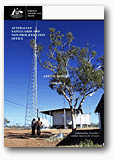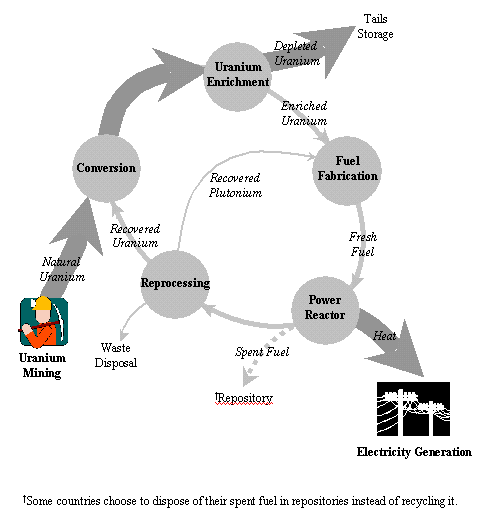


Annual Report 1998-99 |
 |
BRIEF OUTLINE OF THE NUCLEAR FUEL CYCLE
Over 430 nuclear power reactors are in operation in over 30 countries, in many of these supplying a substantial proportion of electricity requirements - see Table 7.
Reactor types
The majority of the world’s power reactors are of the light water type (LWRs—light water reactors), where ordinary water acts as both moderator, slowing down neutrons to efficient speeds for nuclear fission to occur, and coolant, transferring heat from the nuclear reaction to steam generators for producing electricity.
Because ordinary water is an inefficient moderator, LWRs must be operated on enriched uranium, that is, uranium in which the proportion of the fissile isotope U-235 has been increased from the level in natural uranium, 0.71%, usually to between 3 and 5%.
Some reactor types can be operated on natural uranium, by using more efficient moderators, such as heavy water, which has a proportion of the heavier hydrogen isotope deuterium, and graphite. Typical examples of this type of reactor are the Canadian CANDU, wich is moderated and cooled by heavy water, and gas-cooled graphite-moderated reactors such as the UK Magnox.
Fuel cycle stages
Following mining and milling of uranium and production of uranium ore concentrates (yellowcake), the stages of the light water fuel cycle are as follows (see Figure 5):
Conversion: natural uranium is formed into a gaseous compound, uranium hexafluoride (UF6), prior to enrichment;
Enrichment: a process by which the proportion of the U-235 content is increased. The main technologies in use are gaseous diffusion and centrifuge. The product is described as low enriched uranium (LEU), containing between 3 and 5% U-235;
Fabrication: manufacture of LEU into uranium oxide fuel pellets, which are assembled into fuel rods and then fuel elements for use in a reactor;
Reactors: a power reactor uses the heat from a controlled nuclear chain reaction to drive a turbine to generate electricity. Typically the turbine(s) is driven by steam. In the case of pressurised water reactors as well as liquid metal-cooled reactors and some gas-cooled reactors, steam for the turbines is produced in a secondary circuit. There are some high-temperature gas-cooled reactors where the generating turbine is gas-driven.
In a typical LWR fuel elements are used over 3-4 operating cycles each of 12-18 months (i.e. the reactor might be unloaded every 12 months, with a third of the core being replaced each time);
Reprocessing: spent fuel is dissolved for the separation of highly radioactive fission products, and for the recovery of plutonium and uranium. Uranium can be re-enriched for further reactor use. Plutonium is mixed with uranium to produce MOX (mixed oxide) fuel and used both in LWRs and potentially in fast breeder or fast neutron reactors.
Partly because depressed uranium prices are impacting on the economics of reprocessing, a number of countries have committed to, or are considering, the once-through cycle, where spent fuel will be disposed of without reprocessing.
Military fuel cycle
There are five acknowledged nuclear-weapon States (the United States, Russia, the United Kingdom, France and China), and three ‘threshold’ States (India, Israel and Pakistan). In all cases the military nuclear programs developed ahead of civil power programs. Military programs involve the production of special grades of nuclear material, substantially different to the material used in civil programs.
Nuclear weapons are based on the following nuclear materials:
Plutonium: Plutonium is formed through the irradiation of uranium in a reactor. The uranium-238 isotope absorbs a neutron, leading to the formation of plutonium-239. Longer irradiation times lead to the formation of higher plutonium isotopes, Pu-240, Pu-241 and Pu-242.
Weapons-grade plutonium predominantly comprises the isotope Pu-239, and contains no more than 7% of the isotope Pu-240. Pu-240 (and the higher isotope Pu-242) are undesirable for weapons purposes because their rate of spontaneous fission causes pre-initiation (a premature chain reaction). By contrast, ‘reactor-grade’ plutonium from the normal operation of a LWR contains high levels of Pu-240, typically around 25%.
Because of the need to minimise the Pu-240 content, weapons-grade plutonium is produced in dedicated plutonium production reactors, usually natural uranium-fuelled, graphite-moderated, where irradiated fuel can be removed after short irradiation times (i.e. at low burn-up levels).
Uranium: Weapons-grade uranium is very highly enriched, to 90% or more U-235. This compares with normal civil enrichment levels of around 3–5% U-235. High enrichment levels are produced in enrichment plants specially designed and operated for this purpose.
The United States, Russia, the United Kingdom and France have announced that they have ceased production of fissile material for nuclear weapons purposes, and China is believed to have done so. Australia is campaigning for a ‘cut-off’ convention (FMCT) under which this situation will be formalised, and extended to the threshold States. The FMCT will prohibit production of fissile material for weapons purposes, and will provide for verification on relevant facilities and material.
Table 6. Comparison of Materials in Civil and Military Nuclear Fuel Cycles (figures are approximate).
| Material | Civil | Military |
| Plutonium | 60% 239Pu | 93% 239Pu |
| Uranium | 4% 235U | 90% 235U |
Figure 5. Civil Nuclear Fuel Cycle - Outline.

Table 7. World Nuclear Electricity Generation at 31 December 1998.
| Country | Operating Reactors | Capacity (GWe) |
% of Total Electricity in 1998 |
| * USA | 104 | 96.4 | 18.7 |
| * France | 58 | 61.7 | 75.8 |
| * Japan | 53 | 43.7 | 35.9 |
| * Germany | 20 | 22.3 | 28.3 |
| Russia | 29 | 19.8 | 13.1 |
| Ukraine | 16 | 13.8 | 45.4 |
| * UK | 35 | 13.0 | 27.1 |
| * ROK | 15 | 12.3 | 41.4 |
| * Canada | 14 | 10.0 | 12.4 |
| * Sweden | 12 | 10.0 | 45.8 |
| * Spain | 9 | 7.4 | 31.7 |
| * Belgium | 7 | 5.7 | 55.2 |
| Taiwan, China | 6 | 4.9 | 24.8 |
| Bulgaria | 6 | 3.5 | 41.5 |
| * Switzerland | 5 | 3.1 | 41.1 |
| * Finland | 4 | 2.7 | 27.4 |
| Lithuania | 2 | 2.4 | 77.2 |
| China | 3 | 2.2 | 1.2 |
| Slovak Republic | 5 | 2.0 | 43.8 |
| South Africa | 2 | 1.8 | 7.3 |
| India | 10 | 1.7 | 2.5 |
| Hungary | 4 | 1.7 | 35.6 |
| Czech Republic | 4 | 1.6 | 20.5 |
| * Mexico | 2 | 1.3 | 5.4 |
| Argentina | 2 | 0.9 | 10.0 |
| Romania | 1 | 0.7 | 10.4 |
| Slovenia | 1 | 0.6 | 38.3 |
| Brazil | 1 | 0.6 | 1.1 |
| * Netherlands | 1 | 0.4 | 4.1 |
| Armenia | 1 | 0.4 | 24.7 |
| Pakistan | 1 | 0.1 | 0.7 |
| Kazakhstan | 1 | 0.1 | 0.2 |
| World total | 434 | 348.9 | (est) 16 |
* Eligible to use Australian uranium. Countries eligible to use Australian uranium operate 339 power reactors, accounting for around 83% of world nuclear generating capacity.
Source: IAEA Press Release 99/4, 29 April
1999
(http://www.iaea.org/worldatom/inforesource/pressrelease/98table.html)